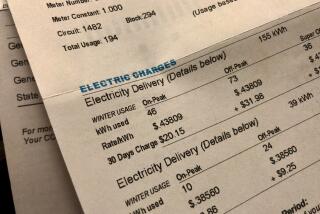Can California do without San Onofre?
Southern California Edison, the majority owner of the nuclear plant on the San Diego County coast, says the answer is no.
That’s the response of the utility’s president, Ronald Litzinger, to my column this week questioning why Edison ratepayers are still forking over $54 million a month in rates for a facility that hasn’t generated a watt of electricity in 13 months -- and may never operate again. (When added to what customers of the minority owner, San Diego Gas & Electric, are paying, the monthly total is $68 million.)
In a rebuttal published today by The Times, Litzinger argues that “even when San Onofre is offline, there are considerable ongoing costs associated with maintaining it.” His point is that customers should continue to fork over those costs.
A few issues with that. First of all, San Onofre is a fiasco, and Edison is the responsible party. The utility oversaw the $770-million replacement of its aging generators with new units that developed unacceptable wear within about 20 months. As a result, the plant was taken offline at the end of January 2012. No one is sure whether it can be restarted -- Edison’s latest plan is to run one of the two units at 70% of capacity for a few months, if federal regulators allow.
The second issue is that no one is saying Edison shouldn’t recover anything for San Onofre; the quesiton is whether ratepayers should be advancing the money now for a dead plant, under conditions that will make it difficult, if not impossible, for them to recover the outlay dollar for dollar even if state regulators order refunds. My column argued that the plant should be taken out of Edison’s rate base now; it can always be restored later, after the full scale of the disaster is known.
Litzinger in his essay treats San Onofre as still a fully active part of California’s electric grid: “San Onofre’s 2,200 megawatts of peak output are a crucial contributor to California’s ambitious clean-energy goals,” he writes.
Is this pretense, delusion, or PR? The fact is that San Onofre has no output. It’s not contributing anything to California’s grid or its “ambitious clean energy goals.” At the moment, as you might hear on Monty Python, it is a late nuclear plant.
Litzinger tries to finesse this by writing that the electricity that Edison customers use is the same no matter how or where it’s generated; therefore they should pay the same as they were before San Onofre went down. It’s an argument that puts Edison’s ratepayers on the hook for any botch by its management, while leaving its shareholders unharmed. He adds that “electricity, like water, is an essential commodity.”
Yes, it is. But that still doesn’t explain why Edison should still be collecting rates today for a plant whose contribution to the flow of that essential commodity is exactly nothing.
ALSO:
Ratepayers get the shaft in San Onofre fiasco
PUC dithers as consumers pay for crippled San Onofre
PUC plan would put nuclear trust fund at risk
More to Read
Inside the business of entertainment
The Wide Shot brings you news, analysis and insights on everything from streaming wars to production — and what it all means for the future.
You may occasionally receive promotional content from the Los Angeles Times.











